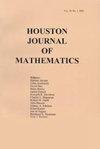部分动力系统与AF C*-代数
IF 0.3
4区 数学
Q4 MATHEMATICS
引用次数: 7
摘要
我们得到了一类r-离散群似群C*代数近似有限维(AF)的动力系统的一个表征。然后利用这些部分同胚的作用来计算AF代数的k理论,并将这些k理论计算应用于AF代数的一些具体例子。最后,我们证明了对于某类维群,可以直接从其相关C*-代数与原维群同构的维群结构中得到群类群。本文章由计算机程序翻译,如有差异,请以英文原文为准。
Partial Dynamical Systems and AF C*-algebras
We obtain a characterization in terms of dynamical systems of those r-discrete groupoids for which the groupoid C*-algebra is approximately finite-dimensional (AF). These ideas are then used to compute the K-theory for AF algebras by utilizing the actions of these partial homeomorphisms, and these K-theoretic calculations are applied to some specific examples of AF algebras. Finally, we show that, for a certain class of dimension groups, a groupoid can be obtained directly from the dimension group's structure whose associated C*-algebra has its dimension group isomorphic to the original dimension group.
求助全文
通过发布文献求助,成功后即可免费获取论文全文。
去求助
来源期刊
CiteScore
0.80
自引率
0.00%
发文量
0
审稿时长
6 months
期刊介绍:
The Houston Journal of Mathematics appears quarterly and publishes original research papers on mathematical topics. It welcomes contributed papers that develop interesting, or important, new mathematical ideas and results or solve outstanding problems. All papers are refereed for correctness and suitability for publication.

 求助内容:
求助内容: 应助结果提醒方式:
应助结果提醒方式:


